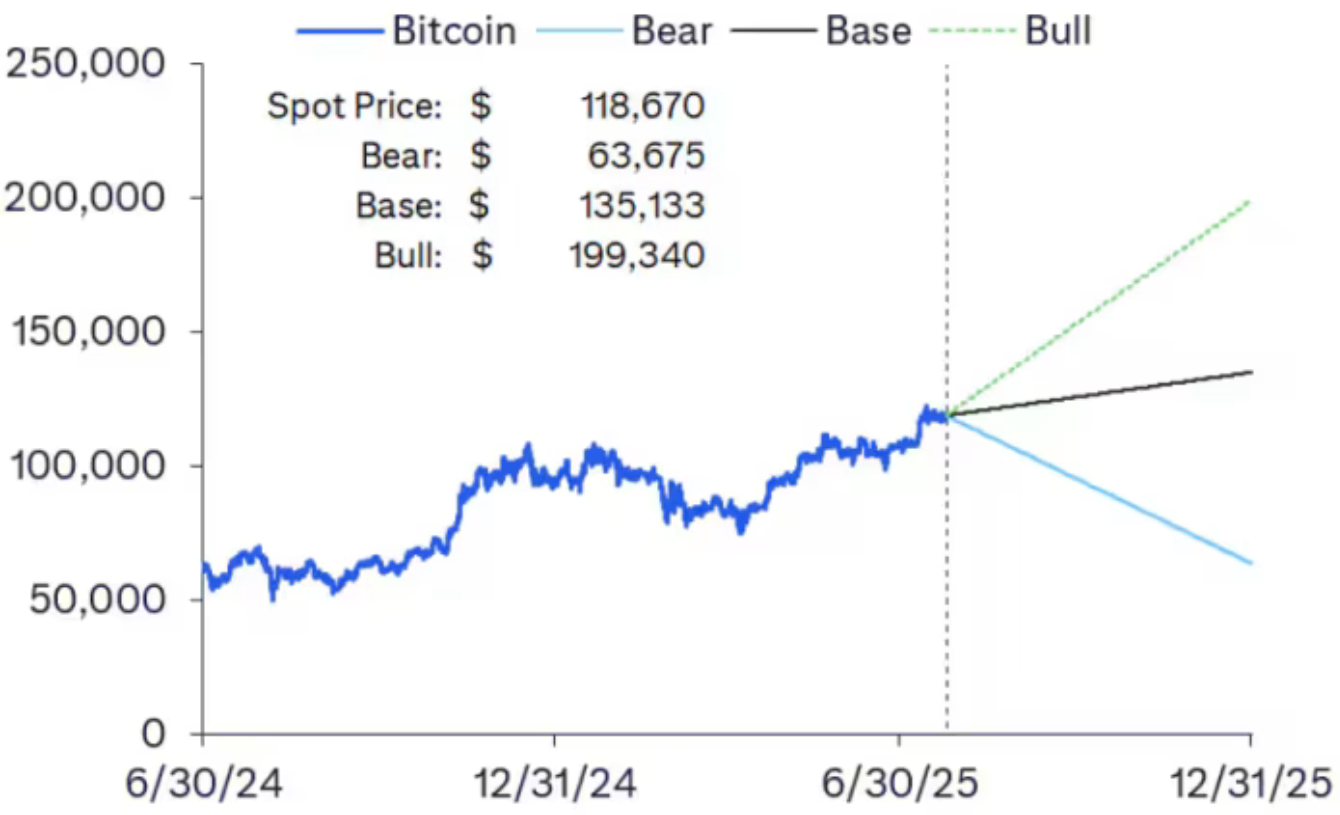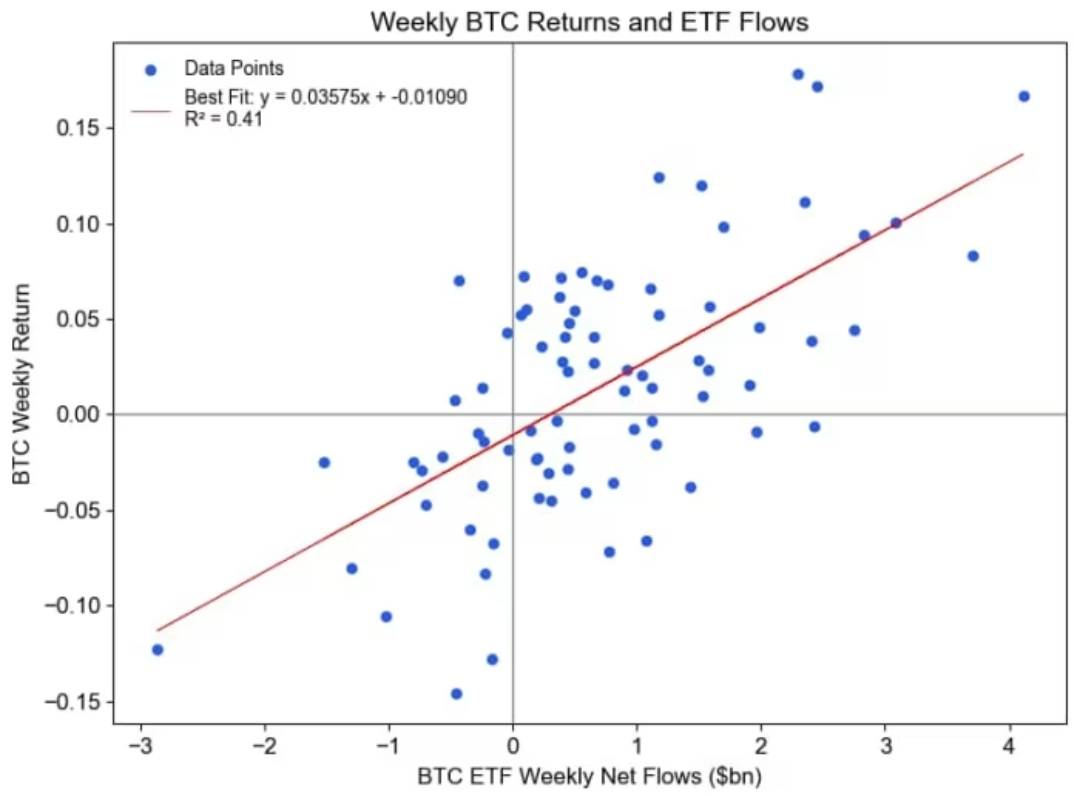This Bitcoin Price Prediction Suggests BTC Will Hit $200K in 2025
Bitcoin (BTC) price prediction just got a major institutional backing as Citigroup analysts reveal their bold forecast for the world's largest cryptocurrency. With Bitcoin trading around $118,700, the banking giant's latest analysis provides crucial insights into why Bitcoin price continues its relentless climb toward new heights.
How High Can Bitcoin Price Go? Citi's $200K Prediction Revealed
Citigroup analysts Alex Saunders and Nathaniel Rupert have released comprehensive Bitcoin price predictions that showcase dramatically different scenarios for the cryptocurrency's future. Their base case target of $135,133 represents a significant upside from current levels, while their bull case soars to $199,340 by year-end.
The analysts' approach represents a fundamental shift in how traditional financial institutions view Bitcoin price dynamics. Rather than dismissing cryptocurrency markets as isolated speculation, Citi now recognizes Bitcoin's integration into mainstream financial infrastructure.
"Crypto assets have grown and now represent a more meaningful amount of capital," the analysts note. "Crypto market-caps now rival all but the largest-cap equity names."
It's worth noting that Citi is not alone in its projections. As early as mid-February, FinanceMagnates.com wrote that Antoni Skaramoty's analysis had gained attention on Bridge Capital, which also suggested Bitcoin could reach $200,000, potentially even this year. Notably, that forecast emerged when Bitcoin had yet to break above the $100,000 mark. Around the same time, VanEck projected that Bitcoin could rise to $180,000.

ETF Flows Drive Bitcoin Price Action
The most striking revelation from Citi's analysis centers on exchange-traded fund flows as the primary driver behind Bitcoin's recent price surge. The research demonstrates that 41% of Bitcoin return variation can be explained by ETF flows alone since the products launched.
This relationship proves remarkably strong across different market conditions. The analysts tracked $19 billion in ETF flows year-to-date, including $5.5 billion in recent weeks. Each $1 billion of weekly flows correlates with a 3.6 percent return increase for Bitcoin, establishing a direct mathematical relationship between institutional demand and price appreciation.

Bitcoin ETFs have fundamentally altered the cryptocurrency's supply dynamics. With nearly 6.8 percent of Bitcoin's total supply now held in ETF structures, these products create sustained buying pressure that traditional retail speculation cannot match.
“Fresh back from visits to the USA, it is clear there has been a significant swing to Institutional usage of digital assets. We saw this at the start of the year with the advent of corporate US BTC treasuries, then with the uptake of ETF activity in BTC and ETH," Pual Howard from Wincent commented for FinanceMagnates.com
Bitcoin Price Prediction vs Technical Analysis
And although Citi’s forecast is extremely bullish, from the perspective of the technical analysis I conducted, the situation on Bitcoin’s chart hasn’t changed much since the first half of last month. We remain in the same consolidation range, between the $116,000 support level and resistance around $120,000, which was established on July 14 when Bitcoin set its most recent all-time high just above $122,000. Since then, the $120,000 level has served as a key resistance that the market has attempted to break through multiple times, but so far without success.

The longer we stay below this level, the higher the likelihood that Bitcoin will enter a correction, as buying momentum weakens and sell orders, whether from profit-taking or bearish positioning, increase. In that case, I would expect a short-term pullback to around $112,000, where the late-May high and the 50-day exponential moving average (EMA) currently align. A break below that level could open the path to the next support near $108,000, which corresponds to the highs from the turn of the year. The final line of defense for the bulls would be the psychological level of $100,000, last tested in mid-June and now aligned with the 200 EMA.
Any move down to that level, in my view, would still qualify as a technical correction, and a potential buying opportunity at more attractive prices. However, a break below the 200 EMA and $100,000 would suggest that bears have regained control. In that scenario, I would start considering short positions, targeting a move down to the April lows near $76,000.
You may also like: Will Bitcoin Reach $200K? 10x Research Shares BTC Price Prediction for 2025
Bitcoin Technical Levels – Summary Table
Level (USD) | Type | Description / Significance |
122,000 | All-Time High (ATH) | Most recent ATH, set on July 14 |
120,000 | Key Resistance | Frequently tested; marks top of current consolidation |
116,000 | Support | Bottom of current consolidation range |
112,000 | Short-Term Support | Late-May high; near 50-day EMA |
108,000 | Secondary Support | High from the turn of the year |
100,000 | Major/Psychological Support | Aligned with 200-day EMA; last tested mid-June |
76,000 | Bearish Target | April low; potential downside target if $100k is broken |
Why Bitcoin Price Is Surging? The Network Effect
Citi's updated valuation framework simplifies Bitcoin price prediction to its essential element: adoption rates. The bank's analysis suggests Bitcoin's value directly correlates with how many people want to own Bitcoin rather than complex technical indicators or speculative metrics.
This approach discards previously popular models like stock-to-flow ratios and mining cost calculations. Instead, Citi focuses on active wallet addresses and network participation as primary valuation drivers.
The adoption model reveals Bitcoin's current price trades above historical network metrics, suggesting mean reversion could provide additional upside over the coming months. With a 36-week average reversion period, current elevated levels may normalize higher rather than correct downward.
Related: Tom Lee Called Bitcoin's Peak In 2024 And Just Made Another Bold 2,400% BTC Price Prediction
Corporate Treasury Demand Amplifies Price Pressure
Beyond ETF flows, corporate Bitcoin adoption creates additional supply constraints that support higher prices. Treasury companies and corporations now warehouse approximately 4 percent of Bitcoin's fully diluted supply, representing billions in institutional capital.
This corporate demand operates independently from ETF flows, creating multiple layers of sustained buying pressure. Unlike retail speculation that ebbs and flows with market sentiment, corporate treasury allocation represents long-term strategic positioning that rarely reverses quickly.
The combination of ETF demand and corporate treasury accumulation removes substantial Bitcoin supply from active trading, creating scarcity dynamics that support continued price appreciation.
Macro Factors Support Bitcoin Price Growth
Citi's analysis acknowledges Bitcoin's increasing correlation with traditional financial markets while maintaining its unique value proposition. The cryptocurrency now benefits from broad equity market strength and dollar weakness while retaining its digital scarcity characteristics.
Bitcoin's integration into major financial indices means crypto-agnostic investors must develop Bitcoin price views to manage portfolio exposure effectively. This forced institutional engagement creates sustained analytical coverage and legitimacy that supports long-term adoption.
The political environment adds another supportive factor, with regulatory clarity enabling traditional financial institutions to increase crypto ecosystem involvement. This institutional onboarding creates self-reinforcing cycles of adoption and price appreciation.
Risk Factors Could Impact Bitcoin Price Trajectory
Despite bullish fundamentals, Citi acknowledges significant risks that could derail Bitcoin price predictions. Low velocity metrics suggest most Bitcoin remains dormant rather than actively traded, creating potential volatility if selling pressure emerges.
The analysts note that Bitcoin velocity currently matches levels from 2010 when 10,000 bitcoins bought two pizzas, indicating extreme illiquidity in spot markets. While this supports current price levels, it could amplify downside moves if ETF flows reverse.
Michael Saylor's MicroStrategy and similar corporate buyers continue absorbing available Bitcoin supply, but this concentration creates single-point-of-failure risks if major holders adjust their strategies.
Why Bitcoin Price Predictions Matter Now
Bitcoin price analysis has evolved beyond speculative trading as the cryptocurrency achieves mainstream financial integration. Citi's institutional framework provides sophisticated investors with tools to evaluate Bitcoin exposure without relying on heuristics or average price assumptions.
The bank's $135,000 base case reflects measured optimism based on continued ETF adoption and institutional integration. However, the $199,340 bull case demonstrates Bitcoin's potential if current adoption trends accelerate through year-end.
As Bitcoin price discovery increasingly depends on institutional flows rather than retail sentiment, professional analysis like Citi's framework becomes essential for understanding market dynamics. The cryptocurrency's evolution from speculative asset to institutional allocation fundamentally changes how Bitcoin price predictions should be evaluated.
Bitcoin's journey toward Citi's price targets depends primarily on continued institutional adoption and ETF flows. With regulatory clarity improving and corporate treasury demand remaining strong, the fundamental drivers supporting higher Bitcoin prices appear increasingly sustainable.
Bitcoin News FAQ
How High Can Bitcoin Realistically Go?
Bitcoin's realistic price potential depends on institutional adoption rates and network effects rather than pure speculation. Citigroup's comprehensive analysis suggests Bitcoin could reach $135,000 to $199,000 within the current market cycle based on sustained ETF flows and corporate treasury adoption.
Will Bitcoin Go to 1 Million?
The million-dollar Bitcoin thesis requires exponential adoption growth that exceeds current institutional integration patterns. Cathie Wood's $1 million five-year forecast represents the most prominent advocate for this target, though her timeline extends well beyond current analytical frameworks.
How Much Will 1 Bitcoin Be Worth in 2030?
Bitcoin's 2030 valuation depends on institutional adoption reaching maturity and regulatory frameworks stabilizing across major economies. Conservative projections from traditional financial institutions suggest Bitcoin could trade between $300,000 to $500,000 by 2030 if current adoption trends continue.
How High Could Bitcoin Go in 2025?
Bitcoin's 2025 potential builds directly on current institutional momentum and regulatory clarity trends. Citigroup's year-end targets of $135,000 to $199,000 provide professional baseline expectations based on measurable adoption metrics rather than speculative projections.



